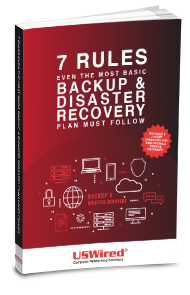Disaster recovery and high availability are two important concepts in the world of cybersecurity. However, there is a lot of confusion about the difference between the two. In this article, we will clear up any misconceptions and explain the crucial distinctions between disaster recovery and high availability. By understanding the differences, businesses can make more informed decisions about their cybersecurity strategies and protect their data more effectively.
Defining disaster recovery
Disaster recovery is a process or plan that helps businesses to recover from a major disruptive event, which could be anything from a natural disaster, like an earthquake or flooding, to a cyberattack. A key part of any disaster recovery strategy is having backups of important data which can be used to restore systems if the original copy is lost or corrupted.
Related reading: Best practices for an effective backup strategy
Not having backups and a solid disaster recovery strategy could be disastrous for any organization, especially if they’re hit by a ransomware attack. Based on a Coveware Quarterly Ransomware Report, recovering from a ransomware attack takes around 21 days. This means a business will be inoperational and unprofitable for about 21 days due to certain machines or IT systems being unusable.
Additionally, according to cybersecurity practitioners, the average ransom payment is around $900,000, a staggering increase from $500,000 in 2021 and $300,000 in 2020.
To recover from such attacks and avoid having to pay an exorbitant ransom, your organization should have the right prevention, response, and recovery strategies in place. This primarily means having recent backups of your most critical data.
Note that there are two main types of backups that are used in disaster recovery: cold backups and hot backups. Cold backups are copies of data that are stored offline and cannot be accessed by users, while hot backups are live copies of data that can be accessed by users even while the backup process is taking place.
Choosing the right disaster recovery solution
The type of disaster recovery solution that a business chooses will depend on a number of factors, including the size of the business, the amount of data that needs to be backed up, and the budget. Small businesses with limited resources may only be able to afford cold backups, while larger businesses may be able to invest in more expensive hot backup solutions.
In any case, it is important for businesses to have a backup plan in place so that the data can be recovered quickly and efficiently in the event of an emergency.
Download our free eBook!
Download our FREE eBook, 7 Rules Even the Most Basic Disaster & Recovery Plan Must Follow.
Defining high availability
Unlike disaster recovery which focuses on recovering from a major disruptive event, high availability is all about preventing disruptions from happening in the first place.
High-availability solutions are designed to keep systems up and running even in the event of a power outage or other types of failure. They typically use redundant components so that if one component fails, there is another one that can take its place.
High availability also refers to systems and components that are designed to remain operational for long periods of time with minimal downtime. These systems are often used in mission-critical applications where even a brief outage could cause significant problems. For example, hospitals and air traffic control towers need to have high availability systems in place to avoid disruptions.
Investing in a high availability solution can be expensive, but for businesses that cannot afford to have their systems down for even a few minutes, it’s worth the investment.
Differentiating disaster recovery from high availability
The main difference between disaster recovery and high availability is that disaster recovery is a reactive strategy that businesses use to deal with the consequences of a major disruptive event. High availability, on the other hand, is a proactive strategy that helps businesses avoid disruptions before they happen.
Investing in both disaster recovery and high availability solutions is the best way to protect your business from the consequences of a major incident. By understanding the difference between these two concepts, you can make sure that your business is protected before, during, and after any disaster.
If you need to know more about implementing a backup and disaster recovery strategy, consult USWired’s team of IT professionals. We have a range of backup and disaster recovery solutions that can protect your business against ransomware and other types of malware. Call us today.




